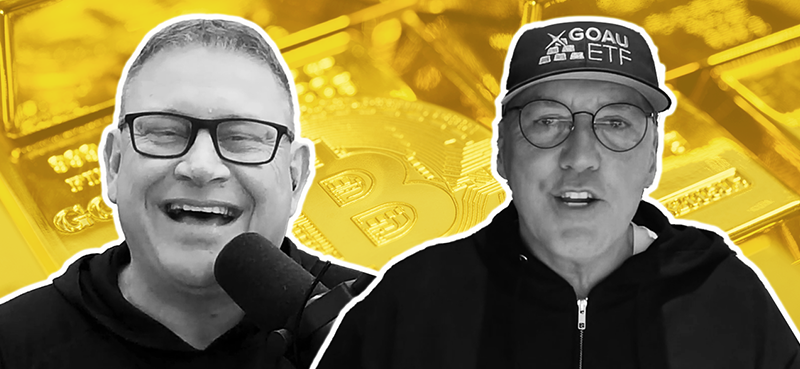Historically, multimillion-dollar artwork has only been available to the highest level of social elites… But a new company is bringing priceless works of art to the average investor—and disrupting a $1.7 trillion industry in the process…
Scott Lynn, co-founder and CEO of Masterworks, shares how his firm gives anyone the chance to invest in multimillion-dollar artwork through securitization. [2:20]
When you’re first to market—especially with a brilliant idea—there’s always a risk of copy-cat competitors… But Scott breaks down the hard work and regulatory hurdles a company would have to go through to offer a similar service. [4:40]
He also explains how fine art can enhance a diversified portfolio… highlights some impressive returns over the past two decades compared to the S&P 500… and gives us a walkthrough of the website—including how it picks artwork… and its unique secondary market. [6:50]
Of note… when he was still in high school, Scott created the most popular internet game of the late ’90s. Today he shares that story. [14:00]
Finally, I share why I’m most excited about the security token market from a macro perspective… and highlight an incredible special offer for my Crypto Intelligence advisory—including how to lock in a free crypto pick. [16:56]
- Scott Lynn of Masterworks on disrupting the fine art space [2:20]
- What you’d have to do to launch another service like Masterworks’ [4:40]
- How fine art can enhance a diversified portfolio [6:50]
- How Scott created the most popular ’90s internet game [14:00]
- An incredible short-term offer to join Crypto Intelligence [16:56]
Wall Street Unplugged | 810
Tokenization just unlocked a $1.7 trillion industry
Announcer: Wall Street Unplugged looks beyond the regular headlines heard on mainstream financial media to bring you unscripted interviews and breaking commentary direct from Wall Street, right to you on main street.
Frank Curzio: What’s going on out there? It’s October 21st. I’m Frank Curzio, host of the Wall Street Unplugged Podcast, where I break the headlines and tell you what’s really moving these markets. I have a great guest for you right now. His name is Scott Lynn, who’s the founder and CEO of Masterworks, which based on its recent capital race last month, is being valued at over $1 billion.
Frank Curzio: Masterworks, the only platform in the world that makes it possible to invest in works from some of the greatest artists. This is an NFTs guys, this is different, and they do this by tokenizing the art, which you guys should know by now, selling off a small piece so anyone can own them. As the value of these works go higher and higher, you could trade your shares at a higher price on their secondary market, which they created or regulated for US investors. Or, if they happen to buy the painting and then you have a piece in it and they sell it, you get proceeds, or a piece of the proceeds, similar to if you own a stock that was acquired. You’re looking at the art market itself, right? Statistics show from 2000-2018 blue chip artist outperformed the S&P 500 by 180%.
Frank Curzio: This is a massive, massive industry. Deloitte pegs it at $1.7 trillion as a total addressable market, but here’s the problem. This is a market which most of you know, that is only available to the elite ultra wealthy, which you see a lot of these assets, right, and commercial real estate and bonds. A lot of this stuff, reserved for the guys that you see on billions or succession, which just started back up again. Man, I love that show. It’s awesome.
Frank Curzio: But Masterworks, your tokenization has now opened up this market to everyone and anyone, as you can own a piece of art from some of the best, most famous artists in the world. Enough of me talking, let’s bring him in right now. Scott, thanks so much for joining us on Wall Street Unplugged.
Scott Lynn: Thanks for having me.
Frank Curzio: I did a lot of homework on you. I have to say, watching of the past 15 years founded, acquired, sold, or still have a controlling interest as shareholder in over a dozen tech companies. But I noticed two industries, secular growing industries, that most of those companies are pretty much from, is online advertising in FinTech. I have to ask, how did this transition into the tokenization of art, where you basically came up with the deal idea for Masterworks?
Scott Lynn: Yeah, no, it’s a good question. I’ve been starting technology companies for 15 years, also collecting art over the same period of time, and have really just appreciated the growth in the asset class. I’ve watched the value of my own collection go up and fundamentally thought that this should be an asset class, that should be available to everyone. But the only way to allocate is, if you have millions of dollars to buy a painting.
Frank Curzio: Let’s go into this, because this is something that you know, as well as I do, it’s been a market for the elites, right? For the wealthy people, yet, let’s talk about a little bit of tokenization. My audience is familiar with this, this is what we did as well, tokenization of our company, where people have an equity stake in Curzio Research, talk about the tokenization, selling off a piece of an asset, but now it seems like the market is so much bigger, right? That area increased in the market size tremendously. I guess there’s a learning curve there, but why don’t you talk about how this site works and how you could actually purchase some of these, or a piece of some of these amazing art pieces?
Scott Lynn: Yeah. We basically go out and we buy a painting with our own balance sheet capital, and we file it as a public offering with the SCC. In your words, we’re really tokenizing individual works of art. In our words, it’s securitizing. As soon as we securitize a painting, investors essentially purchase shares and the individual artwork, and then when the offering is closed, that offering is then available on the secondary market, so people can trade shares in individual artwork. It’s very similar to how public companies work, but we’re doing it for individual pieces of art. Right now, the cadence is around one painting every five days, that’s valued somewhere between $1 million and $30 million. We’re rolling out a lot of these artwork specific IPOs that are at a pretty fast pace.
Frank Curzio: How does it work? Because you’re saying that you’re the only company that actually does this, right? What’s preventing a company from Sotheby’s, which you’re familiar with, who’s been around for hundreds of years, I think close to 300 years, if I’m not mistaken, from actually doing something like this, because when you tokenize, you’re actually bringing a company public, right?
Frank Curzio: You’re looking at right away, the value of this increases 40-60% on average, which again, based on who you listen to statistics, but your value goes up, which makes it enticing for almost anyone who owns these paintings to do it, but do you see Sotheby’s as a competitor, or what kind of proprietary technology you have to stay ahead of this industry, because it seems like you guys are here by yourself and own a massive, massive market?
Scott Lynn: Yeah. We ask ourselves all the time, why are we the only ones doing this? I think when you take a step back and you think about it, as you know, our world is heavily regulated, right? We’re regulated by both the FCC and FINRA and they’re directly or indirectly, building the platform, identifying individual objects in the art market that are appreciating at a faster pace.
Scott Lynn: We have the leading research team in the art market to understand how the market overall is performing, then how individual artist markets are performing. It’s a hard business. On one side, you’re an issuer securitizing these objects. On the other side, you’re an asset manager, figuring out which objects are appreciating most quickly. It’s a combination of really tech skills, finance skills, and art skills.
Frank Curzio: And when it comes to pricing, this data is public, right? You have price discovery on some of these things, which I think might get lost in it because maybe only certain people see it, but I think that has to factor into pricing too, right?
Scott Lynn: Yeah, It’s super interesting. A lot of people think that the art market is very opaque market that it’s hard to understand, but the reality is, out of $60 billion a year that sells in the art market, roughly half of that sells at public auction. You have this massive data set that’s gone back decades if not centuries, to help you understand how the market is performing. It’s really interesting that very few companies, if any outside of us, have really utilized the data to understand returns in the art market, and build investing products based on that.
Frank Curzio: And talk about the returns in the art market, which I think people are not familiar with, because people are familiar with the stock market, and the S&P 500, but you’ve tracked data going back for close to 20 years. Talk about those returns. I think that’d be surprising for people, especially if they’re not familiar with this asset class.
Scott Lynn: Yeah. If you just look at art created after World War II, which is defined as contemporary art, that segment of the art market has appreciated at 14% a year, for the past 25 years. We also like to focus on how does contemporary art correlate or not correlate, with other asset classes, meaning does it trend in the same direction as public equities or does it act as a good diversifier for a portfolio, and when you run those correlation studies, the correlation is negligible between art and other asset classes. I think very high level, we feel like the appreciation rate is really interesting. The correlation factors are really low and it deserves consideration for an investment portfolio.
Frank Curzio: Take me through this in detail, because we explained it, and I want to actually bring up your site here, this way we can take a look. If I want to purchase something, or an art piece. You say how it works, find the best artist, purchase the best art, securitize the artwork with security exchange commission. I see, say allowing anyone to invest. You say you hold the artwork for three to 10 years. If I own that and you sell it. What happens then? And also if I own a piece of it, you have talk about the secondary market, where you could list shares and possibly sell your shares to somebody else, right?
Scott Lynn: Yeah. When we sell the painting, we effectively just distribute proceeds to all shareholders. If you own 10% of the painting, then you would get 10% of the proceeds, but if you click on trading at the top there, you can actually see the secondary market and how individual artworks are trading on the secondary market. There you can see how individual paintings are performing on the secondary market over time, based on investors trading those shares.
Frank Curzio: Now, that’s great stuff. Take me through the learning curve part, because I think if it was the price data, you have the databases and you talk about what you have access to, which is free for investors, and I know when they’ve got to request an invitation through you. But what I notice and what I think is remarkable with what you’re doing, is you’re increasing the total addressable market in terms of the people who, just the average investor, being able to invest in some of this stuff now.
Frank Curzio: What about the learning curve? Because you do a great job with videos here, understanding our alternative real estate. Are you getting a lot of questions on that and seeing strong demand? Because I think there’s a huge demand for this. But sometimes, when it comes to complicated things or things that people don’t understand, that gets lost with that learning curve. “Hey, we really need to explain this on a fifth grade level to why this is a great market for individual investors,” because this is a brand new market, for so many people.
Scott Lynn: Yeah look, our high level position, is that we want to educate people on the art market very broadly, because we think the characteristics from an investment perspective are really compelling, and then the reality is, if they decide they want to invest in art, the only place to do that today is Masterworks. When you look at the website, and the price database page of the website, it’s actually a really unique database, where we’ve went out and we’ve collected paper auction catalogs going back 70 or 80 years, had a team of roughly 30 interns, identify individual paintings that have been bought and then subsequently sold at the public auction. You can understand what someone paid for a painting and then what someone sold a painting for. On an object level, across thousands and thousands of objects, understand how much money collectors made or lost, on individual transactions.
Frank Curzio: How many pieces do you have in your site now, and what’s the most expensive? I’m just curious for my own sake.
Scott Lynn: Yeah. I’m losing track now, but I think we’re on 80 something at this point, the most expensive is a $22-$23 million Basquiat. We’re in this $1 to $30 million range now, where we’re buying paintings, but yeah, I would say the average price is probably $5, $6, $7 million.
Frank Curzio: Now, that’s great stuff, and now I want to congratulate you. You just raised money, which put your valuation, I believe, you can quote me if I’m wrong, at $1 billion or over $1 billion. That’s remarkable. We’re not talking NFT’s here just to be clear. Tokenization is totally different, and people may get confused, especially in today’s market, but what are some of the growth plans? I heard that you plan to buy, I think I saw someplace and that you mentioned $400 million worth of artwork over the next year or something, but what do you plan to do, to really grow this, because it’s such an exciting concept, and it’s original, and you guys are first to the market, which is awesome.
Scott Lynn: Yeah, we should buy close to $400 million in art this year. I think we’ll buy close to $1 billion in art next year. Our growth plan’s really just taking this concept that we build around securitizing art, and then focusing on all types of distributions. Distributing to website investors, distributing to financial advisors, then eventually distributing to institutions. Our view is that again, the asset class is really compelling. There’s no other place to access it outside of us. Whether you are a large endowment, or whether you’re a small retail investor, we’re the only place to get it. We’re right now, just heavily focused on building out teams across all of those segments.
Frank Curzio: I have to tell you, when I look at your business model, I think that to me the biggest asset is, yes you have the art, but the tokenization model, it’s your proprietary technology and platform. Is art the only thing you plan on getting into, which is perfectly fine, because that’s what is it? $1.7 trillion total addressable market? That’s very, very big, but when you’re looking at collectibles, I think it’s 350-370 billion collectables sold just last year, but I feel like it’s almost like Amazon used to be just a book seller, and then it said, “Hey, we have the systems and everything supply chain in place, now we can sell anything in the world.” The system, I think is incredible, a tokenization where you’re light years ahead of so many people. Is it just art, or have you thought maybe collectibles or something else?
Scott Lynn: Yeah, we get asked that question all the time. I think from our perspective, we really view this business as an asset class first business, meaning we operate the website, we operate the platform to help people gain access to these investment opportunities, but art is really the only asset class that we know anything about. I literally know nothing about classic cars. I know nothing about wine, nothing about a lot of these Pokémon cards. Our expertise is really, really deep in art, and we believe that as a platform, if you offer investments to investors that don’t perform, ultimately they won’t come back to the platform. We’re big believers that you have to be an asset manager in these businesses, and you can’t just be a platform.
Frank Curzio: That’s great stuff. Again, looking at what you’ve accomplished in terms of your career and just seeing the markets that you’ve been in, it’s incredible just to see it go this direction, which is awesome. But I am going to have a little fun with you because I realized that you founded the company and correct me if I’m wrong, I got to bring this out, man sorry, but Punch the Monkey. Did you really invent that? That is incredible, because it was all about in late 1990s.
Scott Lynn: Yeah. For those who are, I guess, in their forties now, or older they’ll remember this, but the story was, I was actually in high school when we created that game, and that became the most popular game on the internet in the late 1990s. I graduated high school having a couple dozen employees and learning how to be a CEO for the first time, and then by the time I was 19, it was well over 100 employees or 50 employees, and that game, I think was the 14th most popular website on the internet. But yeah, the story behind the Punch the Monkey banner, which some people remember was just that we tested hundreds and hundreds of ad creatives and different formats, different graphics, different things, whatever reads on that one, perform the best, but that feels like forever ago.
Frank Curzio: I’m sorry I had to do that to you. I had to do it to you, but okay we’ll finish up with this, because I had to have a little fun at the end of the day. But having that marketing background, especially online marketing, what companies do you think are really doing it right? Because it’s such a massive secular growth trend going to grow forever, but you’re probably still involved in a lot of different companies. You’re innovative, you’re seeing companies out there that are, in terms of AI or things like that. And again, that’s outside of the scope, I’m just curious as someone with so much knowledge, you probably see a lot of good stuff within the AI and who’s doing it right, and good companies out there.
Scott Lynn: Yeah. I guess in terms of customer acquisition, it’s really interesting. I would say that I think a lot of companies do it wrong. I think a lot of companies rely on ad agencies, they use high level branding strategies. And in today’s world, there is tons of capital, and they just throw money at it. Masterworks, I think is a really good example of a company that historically relative to our peers, hasn’t actually spent that much money on marketing, but I think has a bigger brand and is more well known. Yeah, interestingly, when you say that there’s not an obvious one that comes to mind for me.
Frank Curzio: No, no and again, I just like to pick your mind about things like that, because I know you’ve been in so many different growth industries. But listen, we’re doing this interview late in the day. I appreciate it. I know how busy you are, again, congratulations on your capital raise. If someone wants to find out more information, learn more about you or about your company. What’s the easiest way for them to do that?
Scott Lynn: Yeah. Yeah. Just go to www.masterworks.com, request access, and then mention that you saw us here, and we’ll help you skip the wait list.
Frank Curzio: No, it sounds great. That sounds great. All right. Thank you so much for coming on and yeah, we’ll have you on you again soon. I really appreciate it. Thanks, Scott.
Scott Lynn: Thanks for having me.
Frank Curzio: Guys great stuff from Scott, and this is what tokenization is. It’s just one small form of it. And say, what we did with our company, same thing. We sell off a piece of shareholders, allowing them to own the equity stake occurs their research, but you’re able to do it on the ground floor. When you’re looking at Masterworks, it’s one application opening up a $1.7 trillion market to the masses.
Frank Curzio: You wonder why I gets so excited. You wonder why I base my whole company on this trend, but you’re looking at how many different applications, companies like ours and lots of companies are coming to us now, to learn how to do this. Now, as the market’s opening up, the real estate market, $250 trillion plus in liquid assets. Why would they do this? Because it raises the value because you’re almost making your stock publicly traded now, which inflates the value by 40% to 60%. Makes sense, right?
Frank Curzio: If you’re looking at a private company and you’re going to trade at four times, five times, EBITDA, whatever earnings, you’re looking at a publicly traded company right now that’s trading 21 times. You have access to the capital markets. You could raise money, you could raise cash, you have a high valuation, use your stock to grow a company. It’s a big difference. That’s why you would sell off 20% of a commercial real estate portfolio, that’s a liquid at a $100 million.
Frank Curzio: You can sell 20% to investors where they could trade this. Now, individual investors could own a piece of commercial real estate, which they’d never have access to, which is awesome, right? Especially in today’s market, low interest rates forever and ever, and ever, and ever, and ever, and ever. Holy cow, and then you look at the company, bringing in $20 million in cash, and their assets are probably going to go even higher because that’s normally what happens when you turn your company to public entity. It’s a win-win for everyone involved. That’s how you disrupt markets, and you do all this by avoiding and going around the middle men on Wall Street, which is why these guys are jumping into this industry, seeing 55% of the banks are now invested in crypto. It’s going to be 100%. They have no choice.
Frank Curzio: These middle men generate huge fees. And now, you’re seeing all this disruption in crypto, in the global bomb market. What’s that, over $120 trillion? NBA contracts that are guaranteed. They could bring in more money. You can have a piece of that. Maybe they provide an interest for that, but $100 million contract over five years, guaranteed. Sell off 30% of it. If it’s an NBA player, whatever it is, they’re bringing in money for themselves. Now you could own that. That’s a guaranteed contract and maybe they provide interest on that, but you look at Babe Ruth rookie cards. Any asset. Now, you know why I’m so excited about this trend. I always jump out of my shoes. It’s not just bullshit.
Frank Curzio: This is something I’m basing my company on, basing my reputation on. This is something that makes sense. If you look at Jeff Bezos, he’s like, “You always focus on the customer.” This is great for the customer. That’s how I always look at this industry. This is something that’s great for retail investors, that they can get in a lot of these things on the ground floor, not when they come out with these crazy stupid valuations, which is insane, insane. But this whole market’s $550 trillion in assets that could be tokenized. The whole thing’s not going to get tokenized. Maybe 40-30% doesn’t get tokenized. If 1% gets tokenized, that’s $5 trillion. The biggest total addressable market I’ve ever seen at $550. You put just 1% it’s $5 trillion. That makes it bigger than cybersecurity, EVs, AI, and marijuana trends combined. Combined. Masterworks billion dollar valuation, like that. That’s how much capital they raised. This is why you need to learn about tokenization, its massive potential, which all happens through crypto.
Frank Curzio: I sent out a video recently. You should have seen it by now. The special offer to describe the Crypto Intelligence, actually the lowest price we offered since our launch four years ago, but it’s not about subscribing. Please watch the video, okay? The potential gains you’re going to see that you can make in this industry. Of course, you’re taking on risk, but you can’t make the… You get 300%, 400% returns, but where are you going to go, Robinhood, or the Coinbases that come out of these crazy valuations, the snowflakes that come out, whatever $70 billion, that’s the first opportunity you got a chance to buy that stock at $70 billion, it’s come down from the valuation, but on day one, after the 100% gain, that’s what it’s opened to retail, the $70 billion. Tell you what, you’re buying it, people are loving, those insiders are loving this.
Frank Curzio: They’re selling the crap out of it to you. They’re like, “Holy cow, I can’t believe this,” and you’re like, “Wow, I’m in Snowflake. I’m so happy,” but most of the growth already took place, but you’re going to see the massive growth in just your average crypto. I bring up free sites in a video it’s like 18, 16, 17, 18 minutes long, very short. But you going to understand the potential of why you really need to get into crypto and learn more about it. This is where you’re going to see the most disruption from, the most innovation. This is the sector. It’s here. There’s no surprise Bitcoin’s hitting it’s high levels. It’s a check mark on every risk that’s out there. You can say inflation, you can say, I hate Wall Street, crazy government spending, limited supply.
Frank Curzio: Hey, that’s a perfect recipe for it to go higher. As it goes higher, you’re going to see a lot of probably crappy things go higher as well, because there’s still a lot of crap in this industry, but you need someone to guide you through it. But with Crypto Intelligence, you’re going to have access to a lot of these great ideas on the ground floor, including a lot of the security token offerings that are going to be launched. They’re going to come out like crazy. Believe me, I know the pipelines. I know the companies that are doing this. I hear from them.
Frank Curzio: They look at us as a platform to gain more interest, which we have a lot of people that are in this industry, which what does that mean? We’re going to get a look, a first look, at a lot of these companies, and that means you can get the chance to invest early in these deals at discounts before they officially launch on platforms like tZERO. That’s normal. eWood access did the same thing. If you invest early on, you get a 10% discount or more tokens and stuff, before they actually… You could trade these things on a platform. Even… We offered a discount to investors as well, when we launched. You were able to get it a discount before we officially launched.
Frank Curzio: If you’re interested in subscribing, please do it through the link, through the video. Again, it’s the best offer that you’ll see on this, since we launched this four years ago. Only open for seven days, that raised the price considerably. You’ll see why, because when you see the video, I’m sharing the portfolio with you, the whole portfolio, win or lose, you’ll see the whole entire thing. Not cherry picking a winner here. You’re going to see, wait until you see the returns that you could possibly make in this. And again, as someone’s covered all these industries, everything, just to see how so many investors, in terms of the risk that they’re taking, the reward is so much greater compared to investing in some of the small caps, especially mid-caps. Yeah, a few of you may have 15x gains, or 10s gains, or had Netflix a while ago. This happens often within this industry. There’s a lot of companies that take off that surge in value.
Frank Curzio: I talk about Dogecoins either and the BS and all that, the pump and dump schemes. There’s very, very good companies within this, they’re innovative companies, you’re not seeing a lot of bullshit come out. You’re seeing Andreessen Horowitz, some of the top venture capitalists invested in this. Bank’s investing in it. Fidelity’s investing in it. You’re seeing these names on these new companies that are coming out to the market, which is incredible. These are big companies with deep pockets, investing in this industry right now. It’s here. It’s not going away. It’s integrated into everything. They can’t get rid of it now, it’s too late.
Frank Curzio: They’ll crush the markets. Too many banks are integrating Blockchain, and Bitcoin, and Ethereum into their systems, and everybody wants it. Their clients want it and they have no choice, because they’re charging these massive fees for things you’re not going to need fees for anymore. You’re not going to get charged. Look at the DeFi market, $80 billion growing 10x. Put that in perspective. It’s already what, twice the size of marijuana? Everyone wants to invest in marijuana. It’s great, trend, awesome. DeFi, twice as big growing much, much more faster. This is just one little segment inside of crypto. You got NFTs, security tokens.
Frank Curzio: We have seven days. If you’d like to get a subscription, take us up on a subscription to the newsletter. It’s Crypto Intelligence, if not, no worries, but watch the video anyway. You need to educate yourself on the sector. I’ve been saying it for at least two to three years. If you listen, you’re probably bought into Bitcoin, bought into a couple things and doing very, very well. That’s just the beginning. That’s the foundation. Now, you’re going to see a lot of the innovation take place. Just like what you saw at the internet guys. The same thing with the internet. You’re looking at the beginning part in 90’s, streaming didn’t exist. 5G didn’t exist. AI didn’t exist. Social media didn’t exist. These are all innovations off of the internet. Now crypto, the foundation’s built. Now, you’re going to see all these innovations getting much, much easier. By the way, do not buy Bitcoin through that ETF.
Frank Curzio: Please, please just buy it, there’s so many sites you could buy it on. It’s bad for retail investors. Good for institutions. I’m surprised that was the one that they passed. You’re going to see more coming out. Anyway, just a little tidbit there, but we watched the video. I share my portfolio. You’re going to see the performance of the portfolio. I’m not going to show you the stock picks. Otherwise, I’ll lose all my subscribers that paid a lot of money for it. But you’re going to see all the gains.
Frank Curzio: There’s five stocks right now you could buy, or five cryptos you could buy right now, that are in all those trends I just mentioned within crypto. Very exciting stuff, can open up for seven days. If you’re interested take it, if not no worries, but definitely watch the video, no matter what. It’s for free, it’ll be worth 15-16 minutes of your time, and you’ll understand the huge gains, and it’ll force you to get into this industry and learn more about it, because it really, really, really is incredible. And you’re going to see lots of innovation, lots of smart people, lots of great people in this industry, and I’m really excited about it. I’m excited to be a part of it, excited to be all in on it, and it’s going to be fun in the years and decades ahead. Guys, that’s it for me. I really appreciate all the support.
Frank Curzio: I’ll see you guys next week. Take care.
Announcer: Wall Street Unplugged is produced by Curzio Research, one of the most respected financial media companies in the industry. The information presented on Wall Street Unplugged is the opinion of its host and guests. You should not base your investment decision solely on this broadcast. Remember, it’s your money and your responsibility.
Editor’s note:
Frank uncovered a tiny crypto he believes will soon replace Ethereum as the second- biggest crypto in the world behind Bitcoin… And hand you 25x gains in the process.
To find out what it is, sign up for Crypto Intelligence with Frank’s new limited-time offer… and get another high-upside crypto pick—FREE.
But hurry—there are only a few days left.
























